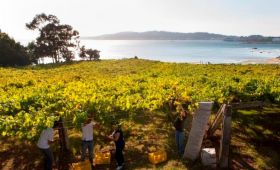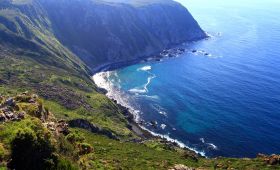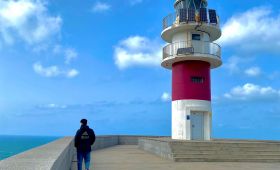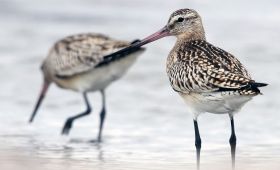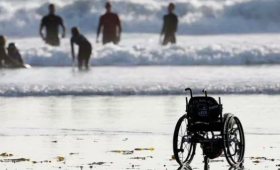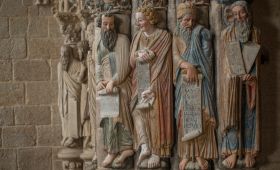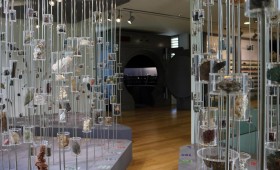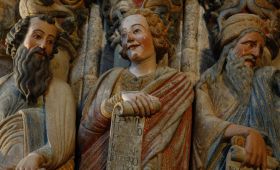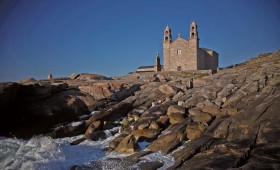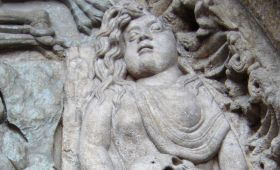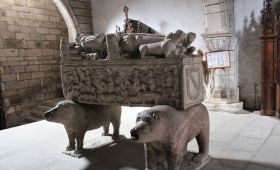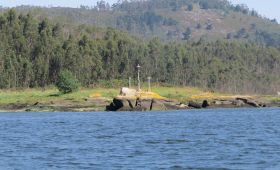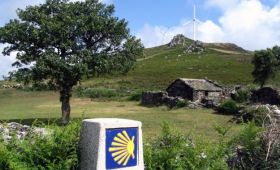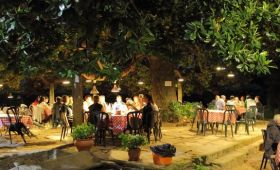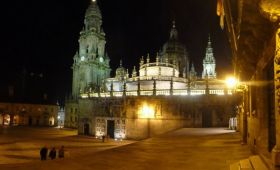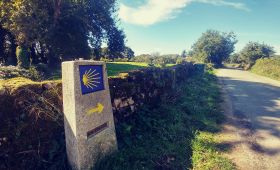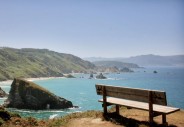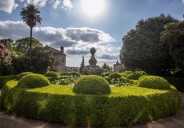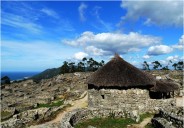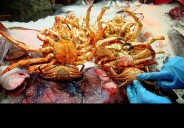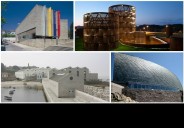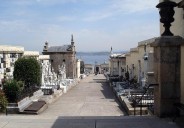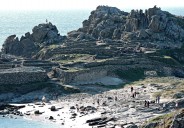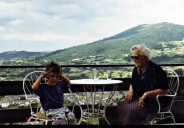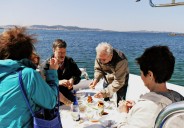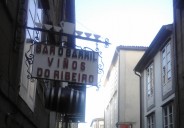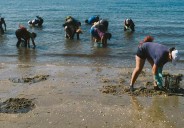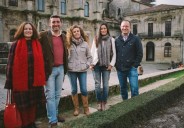Blog
-
Vixia Herbeira: the highest cliffs in Continental Europe
23/03/2022In the middle of Serra da Capelada we can find the viewpoint of Vixía Herbeira, where we can observe its cliffs of more than 600 meters high, considered the highest in Continental Europe. Get to know with us this place and others in our excursion "Route of the Cliffs", departing from Santiago de Compostela.
-
Cape Ortegal and its lighthouse: where the Atlantic and the Cantabrian Sea meet.
21/03/2022The area of Cabo Ortegal in the municipality of Cariño is not only interesting at a scenic level, but also has many other attractions that we will discover later. Declared a Site of Community Interest (SCI), this point is a passage of migratory birds, and due to its proximity to the estuary of Cariño and Ortigueira, is an environment of great ecological value in which we can see many different species of birds and marine species such as dolphins.
-
-
Those other travellers
08/07/2019They are so small that we would rarely notice them while we are waiting to catch our flight. They do not need to present their visa or boarding pass as all of this is written in their genes. And they don't usually check in either because they tend to be travel light. They are not invisible, but we hardly notice them. And yet they fly, they fly a lot more and better than all of us. The birds, those old friends who have been crossing the sky since before man appeared upon the earth. The ones, maybe, that awakened in us the dream of traveling. The same ones that set a course for the first lost sailors. A species specially designed to see the world in all its magnitude. And even though they are here, with us, anywhere on the planet, why are we rarely aware of them?
-
Accessible tourism in Galicia
18/06/2019Accessible tourism in Galicia: step by step towards normalcy
Part of the charm of Galicia is probably that there are a lot of hard-to-reach corners. Rugged lanscapes, remote small villages with poor or even zero public transport service that could stir up curiosity to the most adventourous spirits; tiny natural areas where if there are half a dozen of people, the spell could be broken. Perhaps, not everyone can easily get to these places, and it might be desirable to preserve small paradises because of the difficulties to access them.
-
The Saint of Croques in the Portico of Glory
The Saint of Croques is one of the most popular images in the Portico of Glory. For many years, hundreds of visitors came to Santiago and performed the traditional “hit with the head”. When did this custom begin? Who really is the Saint of Croques?
-
Sargadelos, galician ceramic with over two centuries of history.
31/08/2018Many will recognise the design of Sargadelos ceramics, since throughout its more than 200 years of history it has become not only a typical Galician souvenir but also a symbol of Galician identity and culture. But how did this well-known brand started?
-
The Plaza de la Quintana and its most outstanding buildings
06/08/2018The place where our office is located, the Plaza de la Quintana, is perhaps one of the most interesting squares of all the cities and one of the essential points of visit of Santiago de Compostela. Discover with us the cultural heritage that surrounds it and its hidden secrets.
-
The main museums of Santiago: art, history and science
17/07/2018Discover the wide variety of museums in Santiago de Compostela, from the well-known Museum of the Cathedral to the Natural History Museum of the USC, among many others. The city offers multiple temporary and permanent exhibitions for all types of public.
-
Art Nouveau in the city of Coruña: the residences of the bourgeoisie
05/07/2018After a period of economic growth in the late nineteenth century and the spread of a more liberal thought in the city of A Coruña, the new bourgeoisie built around the area of the Ensanche a group of unique houses, under the artistic movement of modernism. Plant motifs, inspiration from oriental cultures and women's busts decorate the buildings of the modern part of the city.
-
The Portico of Glory and its original polychromy after 50,000 hours of restoration work
02/07/2018The Portico of Glory, sometimes referred as the "Sistine Chapel" of Romanesque art, was inaugurated on June 2 at a ceremony in the presence of Queen Sofia, revealing its renewed appearance after 10 years of restoration work. Its original polychromy was recovered thanks to a project in collaboration with the most prestigious universities in the world, by the use of several innovative techniques, which have served as a precedent for this type of work.
-
The cult of the Muxía stones
21/06/2018Since Pre-Christian times until nowadays, the Sanctuary of Nosa Señora da Barca in Muxía and its surroundings remain as a sacred place of worship. Thus, the properties and legends related to the stones that surround the shrine and the history of this place in relation to the Apostle Saint-James are of great importance.
-
The “adulterous women” of Platerías, reality or legend?
19/06/2018In the southern façade of the Cathedral of Santiago de Compostela we can see one of its most famous representations, but who is she? An adulterous women, Mary Magdalene or Eve?
-
Albariño wine: the most famous grapes of Galicia
20/04/2018Eating seafood accompanied by a good Albariño wine is one of the greatest gastronomic experiences that we can enjoy in Galicia, and the best place to do so is in Rías Baixas. We invite you to taste a good Albariño wine in one of the tours we offer at Artnatura.
-
The Portico of Glory: the Romanesque jewel of Santiago´s Cathedral
07/04/2018One of the most famous elements of the Cathedral of Santiago de Compostela is the Portico of Glory, considered one of the masterpieces of the Romanesque.
-
Why do we know it as the Coast of Death?
04/04/2018Why do we know it as the Coast of Death? The mention of "death" in its name causes curiosity and makes us wonder about the origin of the term and the meaning behind it...
-
The camellia route: natural beauty and cultural heritage
14/03/2018The wet climate of Galicia has facilitated the development of the camellia, having almost 8,000 different varieties of this symbolic flower. The gardens of the Galician pazos began to be adorned with the camellia and, soon, its use extended in a spectacular way. The camellia blooms in winter, that's why we invite you to discover the Camellia Route that combines cultural heritage and natural beauty through its landscape environments.
-
The small underground mausoleum of the Cathedral of Santiago
02/03/2018Under the main altar of the cathedral of Santiago de Compostela is the urn where the remains of the apostle Santiago and his disciples Atanasio and Teodoro are kept. Come with Art Natura to discover the most sacred space of the Cathedral of Compostela
-
The church of San Francisco de Betanzos and its peculiar funerary sculpture
22/02/2018Today we enter the Church of San Francisco de Betanzos, the fourteenth century, located in Betanzos. Here rest the remains of Fernán Pérez de Andrade, the patron of the church, in one of the most beautiful funerary monuments of the Gothic style in Galicia. Join us to know the figure of Andrade approaching the history of this Galician church.
-
The traslatio: origin and present
14/02/2018Pilgrimages to Santiago are a phenomenon that does not happen by chance. Nothing happens by chance in the history of Santiago and is that to understand the enormous tradition of pilgrimage that exists in this city we must go back to the discovery of the tomb of the Apostle and the theme of traslatio; that has originated a new tourist route that is worth enjoying.
-
Camino de Santiago and Self-exploration
07/02/2018Camina hacia tu esencia is the name of the Camino de Santiago and Self-exploration program, being this a new way of pilgrimage where you can connect with your essence and enjoy this experience through all your senses.
-
Furanchos: the secret gastronomy of Galicia
26/01/2018Typical of the gastronomic tradition of Galicia, furanchos have been booming for some years. We invite you to discover with us this unique experience.
-
The castle of Rocha Forte: a journey through the history of Compostela
22/01/2018We get into the castle of Rocha Forte, the most emblematic castle of Santiago de Compostela. Through him we will be participants in two centuries of the history of Compostela.
-
The "hórreo" of San Martiño de Ozón
19/01/2018Speaking about hórreos in Galicia is talking about a common element within their own landscape. Today we present the hórreo of San Martiño de Ozón, one of the largest in Galicia.
-
The wound left behind by the Prestige oil tanker
18/01/2018In September of 2003, a year after the oil tanker Prestige sank in the Galician coasts, it is inaugurated in Muxía A Ferida, a work by the sculptor Bañuelos-Fournier that pays tribute to all the volunteers who collaborated in the cleaning of the coast.
-
A sombra do Peregrino: places to discover
17/01/2018// >Quintana Square holds one of the mysteries of Compostela that appears overnight: the Pilgrim's Shadow. You will find out more about the legend that surrounds this emblematic image in this post.
-
Discovering the Cathedral of Santiago
Visit with Art Natura the Cathedral of Santiago. Without queuing nor waiting, and always accompanied by one of our official guides.
-
Art and nature: Palace of Rubianes
The Palace of Rubianes, in Villagarcía de Arousa, is an ensemble of art, history and tradition that has become one of the most visited tourist resources in the Ría de Arousa thanks to its garden and its more than 800 different species of camellias.
-
The Yoga Way
05/01/2017If The Way is already an unforgettable experience, to include the practice of yoga will make it more special and rewarding at the same time, and from Artnatura we want to offer you this unique opportunity.
-
The biggest 'hórreo' in Galicia
12/12/2016Hablar de arquitectura popular en Galicia inevitablemente significa hablar de los hórreos y, por consiguiente, del hórreo más grande de Galicia, un debate latente aún hoy en día.
-
The best "bank" in the world
This bench is already considered the best in the world. Located in Loiba's cliffs, it allows a perfect view of the ocean. That's why it attracts more and more visitors as time goes by.
-
Santiago (é)tapas
The most important gastronomic event of the Galician capital city is back. From November 17th to December 4th, we have a date with the IX (é)Tapas Contest in Santiago de Compostela, a unique opportunity to enjoy the Galician cuisine.
-
The "Galician Versalles"
The Pazo de Oca hosts one of the most important examples of gardening of Galicia. Its Baroque gardens have great botanical diversity, being the camellias its major exponent.
-
History of Galicia: Santa Tecla “Castro”
02/09/2016The fortified villages of the pre-Roman era are strategically spread out along Europe. However, the best and largest selection may be located in Galicia. Here, the culture of this civilization has been given an own name, the “castreña” culture.
-
Monastery of Santa María de Oia
29/07/2016The town of Oia, located in the coast of Pontevedra, is considered a distinctive landscape paradise, and it constitutes the best preserved natural area of Galicia. Magic radiates from this fantastic land, famous for its most precious treasure: the Monastery of Santa María de Oia.
-
While in Compostela, eating becomes a pleasure.
11/07/2016Are you a food lover? We invite you to visit one of the most special spots of the Galician capital city: the Plaza de Abastos. It is a place where the perfect conjunction between top quality gastronomy and the best raw materials form one of the best kept secrets of Compostela.
-
The Coast of Death, land of lighthouses
06/05/2016The Coast of Death is one of the Galician places in which most shipwrecks have been registered over the last centuries due to its rocky orography and its high cliffs. This has provoked the construction of lighthouses during the years in order to avoid these sinkings or the natural disasters they give rise to in this coast. In this post we will highlight 8 of the most important lighthouses in the Coast of Death.
-
Contemporary architecture in Galicia
28/04/2016Galicia is a touristic destination well-known mainly because of its historic and artistic heritage, its gastronomy and enology, and for its natural landscapes. However, it is also worth mentioning the modern architecture and the authors that in the last decades have left its mark in the Galician community, creating works of art that have transformed the urban planning of the territory.
-
Necro-tourism: cemeteries and art
Over the last few years, a new typology of tourism with the cemeteries as main characters has become a trend: the necro-tourism, which emerges as a way to make known the historic and artistic heritage of a given territory through graveyards.
-
World Heritage Sites in Galicia
World Heritage Sites in Galicia: which are them? When were they officially recognized by the UNESCO? Which places are waiting to be recognized?
-
Festive Galicia
The Galician summer is here. And with it, all parties and festivals arrive.
-
Galicia, a treat for the taste
There are many people who come to Galicia attracted by its food and its products, especially the fresh ones, such as fish, seafood or meat. Also vegetables, cheeses, preserves, wines, beers, ciders, spirits, cold meats, desserts, sweets in general... Which are the specialties most demanded by visitors?
-
Atlantic Castros: pre-Roman history a few meters from the sea
Since the late Bronze Age to the beginning of our era (approximately between 700 BC and 1 AD), in the northwest of the Iberian Peninsula, in what would later be called Roman Gallaecia (actual Galicia's territory, plus the north of Portugal, greater part of Asturias, Leon, Zamora...) it was developed what now is commonly known as castrexa culture.
-
Ecological tourism in Galicia
Galicia is one of the regions of the world whose territory is more protected and recognized by various international institutions, such as UNESCO and Red Natura 2000. Talking about Biosphere Reserves, Galicia has 6, representing a quarter of the area of the region.
-
Costa da Morte: beauties and mysteries of the western Galicia
It is the west of the West. The last line of ground before crossing to America. The first point of the continent that sailors sight when they come from the other side of the ocean. It is a limit, a strip, a beyond. Many are the conditions that make this part of Galicia a magical and mystical place.
-
A Mariña Lucense: castrexos and romans beaches and lands
10/05/2015First article in collaboration with the newspaper Galicia Confidencial and its Trends section GC Tendencias. A walk along A Mariña Lucense: Ribadeo, Barreiros, Trabada, Foz, Burela, Cervo, Xove, Mondonedo, Lourenzá, Viveiro, Alfoz, O Valadouro, Ourol...
-
As Catedrais and Rodas, two world-class beaches
In the last years we have seen how various rankings have included two Galician beaches among the best in the world. Perhaps the one of the British newspaper The Guardian and the one of the website Tripadvisor were the most notorious, for their size and international reputation.
-
Approaching the culture and economy of the sea
One of the opportunities that Galicia offers as a tourist destination is to know firsthand the culture of a people attached, like few, to the sea. With over 1000 km of coastline Galicia has more km of border with the sea than with the land.
-
Finisterre: the old end of the world... and what else?
It is much more than a place, much more than a municipality, much more than a tourist destination. Finisterre is a symbol of Galicia, a hallmark serving Galician worldwide to explain where they come from.
-
Paris to Dakar, without leaving Santiago
There are two ways to walk down the cobbled street of Rúa do Franco, one of the main streets in the old quarter of Santiago de Compostela. The first is with blisters on your feet, your skin red from the sun, and a sense of expectation in your heart as you walk the last few hundred metres to the Cathedral. The second is less well-known, despite its popularity among locals. Walkers of this type normally have a glow in their cheeks -due to the effects of drinking wine-, a full stomach and a swaying motion to their step.
-
Eva Perón's tree
It is an abies nordmanniana from the Caucasus. This particular example came to Santiago de Compostela's La Alameda Park in illustrious hands, those of María Eva Duarte de Perón (Evita). According to tradition, the conifer was planted by the Argentinean first lady during her visit to the city in 1947, as part of her tour in Spain.
-
Guimatur, a tribute to Galician shellfish gatherers
For some years now, we collaborate with the women who harvest shellfish in the the Galician region with largest shellfish resources, in the old quarter of Santo Tomé in Cambados (Pontevedra). When they started their activity, we were among the first companies to work with them to guide and teach our clients in the experience of being shellfish gatherers for a day. This is Guimatur: a tribute to Galician shell-fisherwomen.
-
Our paradise, Segade
07/12/2013// >This place has a valuable story behind it and in this post we want to talk about one of our favorite areas when we are touring around Caldas de Reis, the Portuguese Way, Pontevedra or the Rias Baixas. Our paradise, Segade.
-
Welcome Art Natura
20/11/2013// >As we are writing these words, we can not but remember how our professional journey began some years ago... over 20 years ago, being more specific. The journey was hard, with many ups and downs, but always with a fixed direction into a job we love and of which we are very grateful: that of being an official tour guide in Galicia.
